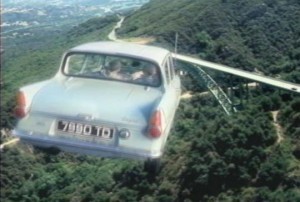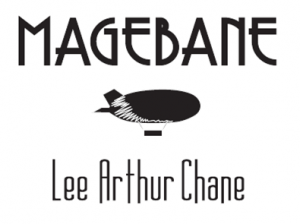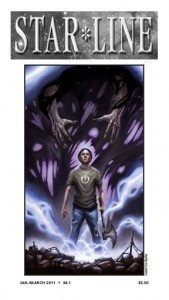Edward Willett's Blog, page 62
July 3, 2011
Magebane galleys are here!
Which means I get to spend the next few days re-reading my own book, and hoping the only errors I see are little ones that are easily corrected, and not major "what-was-I-thinking-aargh-it's-too-late-to-fix-it-now!" ones.
Here's the title and byline from the title page. I love the little airship logo, which appears at the start of each chapter:
And here's the inside-front-flap copy, a small excerpt from fairly early on in the book:
CLOSER AND CLOSER DREW THE WALL OF FOG.
Periodically Anton lit the burner to keep them at five thousand feet. Finally the Professor said, "I think it is time to ascend."
Anton pulled back on the throttle. The flame roared, and the airship began to rise through the cold prairie air.
Five thousand . . . six thousand . . . seven . . . eight . . . up and up they went, and still they could not see over the Anomaly. At nine thousand feet their rate of ascent slowed, and the Professor, frowning again at the rock gas tank, said, "I believe we will release ballast, Anton. If you would open the tank?
"Yes, Professor." Anton bent down and turned a knob protruding through the floor of the gondola at his feet. The airship lurched, then rose much faster than before.
Ten thousand feet. Eleven thousand. Twelve, and they were slowing again. They were almost to the wall of fog marking the Anomaly, and still it rose above them, an impossible cliff of white, swirling vapor. Was it his imagination, or could he feel the chill from it even through his warm leather flying gear?
The Professor peered up into the fog. "I think we need another two to three thousand feet," he said, his voice grim but determined. "Release the sandbags, please, Anton."
The ropes dropped from the side of the gondola, the sandbags slipping off them to plummet toward the prairie below. Suddenly, it felt like a giant had grabbed them and hurled them, spinning, into the sky. The world whirled through Anton's vision, wall of fog, sunlit prairie, wall of fog, sunlit prairie. The spinning, mercifully, stopped, but hard on its heels came the unmistakable sound of tearing silk. . . .
So, whaddya think? If you read that as a teaser at the front of a book, would you buy it?
June 28, 2011
Corked bats, juiced balls, and humidors
 Scientists, like people in general, tend to like sports. Maybe that's why "science of sports" studies pop up, rather like fly balls, at regular intervals: a metaphor that's particularly apt when the study involves baseball…like the one I'm about to describe.
Scientists, like people in general, tend to like sports. Maybe that's why "science of sports" studies pop up, rather like fly balls, at regular intervals: a metaphor that's particularly apt when the study involves baseball…like the one I'm about to describe.
Authored by Alan Nathan of the University of Illinois, Lloyd Smith and Warren Faber of Washington State University, and Daniel Russell of Kettering University in Flint, Mich., "Corked bats, juiced balls, and humidors: The physics of cheating in baseball," just appeared in the journal of the American Association of Physics Teachers.
The researchers set out to investigate, from a physics perspective, three "questions of relevance to Major League Baseball": "Can a baseball be hit further with a corked bat?" "Is there evidence that the baseball is more lively today than in earlier years?", and "Can storing baseballs in a temperature- or humidity-controlled environment significantly affect home-run production?" Their experiments took place in the bat-ball test facility at the Sports Science Laboratory at Washington State University.
The first question under consideration was whether a baseball can be hit farther with a corked bat. The researchers note that in 2003 Sammy Sosa of the Chicago Cubs was caught using an illegally corked bat: a wooden bat that has been drilled out lengthwise and filled with a lightweight inert material.
The theory behind corking is that, because the bat is lighter, players can swing it faster and therefore hit the ball farther. But the counter-argument is that a lighter-weight bat imparts less energy to the ball on impact. So…does a corked bat work?
To find out, the researchers fired a baseball from an air cannon at 110 mph onto a solid wooden bat, then on the same bat with a hollow interior, and then with the interior filled with cork. (They'd intended to try the experiment with the bat filled with superball material, too, but the bat broke.)
They measured the speed at which the ball hit the bat, and the speed at which it rebounded, using those measurements to calculate the coefficient of restitution, or COR, the ratio of the outgoing velocity of the ball to its incoming velocity. They found that the COR was identical, no matter what they did to the bat.
What about the swing speed? The effect of swinging a lighter bat faster versus a heavier bat slower, when both have the same COR, can be calculated mathematically, and the calculations were clear: the higher swing speed wouldn't do the batter any good. In fact, a corked bat will usually hit the ball a shorter distance, not a longer one. The only advantage that a corked bat might give is allowing the batter to react faster.
The next question was whether today's baseballs are livelier than those of the past, a question that pops up (rather like an overworked metaphor) whenever there's a spate of home runs.
By good fortune finding several unopened boxes of baseballs from the late 1970s, the researchers were able to compare 35-year-old balls to modern ones, firing both against both flat surfaces and bats at speeds ranging from 60 to 125 mph. Again, they found no significant difference between the old balls and the new balls (although of course that says nothing about balls from even older eras, as the researchers are the first to admit).
Finally, the researchers set out to see if the Colorado Rockies' practice of storing their baseballs in a humidor with a constant temperature of 70 degrees and a constant relative humidity of 50 percent, to counteract the effect of the lower air density in Denver, could account for the decrease in offensive statistics at Coors Field since 2002.
Sure enough, they found that the COR fell by 4.5 percent when the relative humidity at which the ball was stored increased from 30 to 50 percent. They estimate in an actual game the humidified balls would fly 14 feet less on average than regular ones, which could cut home runs by a quarter.
They also found you could cut home runs even more with cold baseballs: the COR fell by 3.3 percent when the storage temperature was decreased from 70 to 35 degrees F, translating to an average 10-foot reduction in flight distance, and a 19-percent reduction in home runs.
So the answers to the three questions? No, no and yes, respectively.
In baseball terms, that's batting .333. In science terms, that's batting a thousand.
(The photo: Toronto at bat against Baltimore, in Toronto, summer 2008.)
June 22, 2011
D-Dalus: Dawn of the flying car?
 "Hey, dude, where's my flying car?" is a cry every science fiction writer has heard—and every science fiction reader has uttered—since the future supposedly arrived on January 1, 2001, and we found ourselves still stuck to the ground, rolling along on rubber tires.
"Hey, dude, where's my flying car?" is a cry every science fiction writer has heard—and every science fiction reader has uttered—since the future supposedly arrived on January 1, 2001, and we found ourselves still stuck to the ground, rolling along on rubber tires.
The problem has been that we really only have a few ways to get ourselves into the air, and none of them really lend themselves well to flying cars.
But a new technology presented at the Paris Air Show proffers the possibility of, not only flying cars, but more stable, easy-to-fly and mechanically robust aircraft for a plethora of purposes: the first "disruptive technology"—technology that changes everything and seriously shakes up an industry or market—in aviation since the jet engine.
The brainchild of the Austrian research company IAT21, the D-Dalus (a play on Daedalus from Greek mythology, which you have to admit is a much better choice than Icarus) is neither a fixed-wing nor a rotor aircraft. Instead, it is propelled by four mechanically linked contra-rotating cylindrical turbines, all spinning at 2,200 rpm.
Servos can turn the blades through a full 360 degrees around all three axes. That allows the D-Dalus to launch vertically, hover perfectly still, and move in any direction, a complex process made simple by computers: all the operator has to do is manipulate a simple joystick. That means the D-Dalus is far simpler to fly than any helicopter. (That's not the only way it's simple: it's also simple mechanically, so simple that it requires little maintenance and what little is required can be done by someone with no more mechanical expertise than your average auto mechanic.)
Speaking of helicopters, they and all our other existing VTOL (vertical takeoff and landing) aircraft are challenged by bad weather and flying long ranges. They're also hard to land on moving platforms, such as boats in rough water.
But D-Dalus, according to its developers, suffers from none of these problems. Its ability to thrust upward allows it to "glue down" as it lands, even on a moving vehicle or tossing boat. It's extremely stable, handling rough weather with ease.
That stability, combined with a built-in sense-and-avoid system to keep it from running into things, and the fact it has no vulnerable external parts (unlike a helicopter, for example) means the D-Dalus can hover very close to cliff faces and building walls (making it potentially very useful for search and rescue missions).
The lack of external moving parts also gives the D-Dalus 360-degree vision: no blind spots in any direction. Throw all of these capabilities into the pot, along with the fact it's nearly silent, and it's not surprising the military is interested in it for surveillance drones.
But there are many other potential uses. The D-Dalus is so stable, it could even be flown safely into a building through an open window. Once inside, it could be used to remove explosives or contaminants, extract injured people, or even hold and direct water hoses for fire fighters.
D-Dalus aircraft can lift heavy loads, and the bigger they are the more efficient at lifting they become, which means they could be used as skycranes for loading and unloading ships when regular cranes aren't available. The current D-Dalus has a 120 bhp engine, rotors five feet long, and can lift up to 70 kg, but IAT21 is working with Cranfield University in the U.K. on a version with a larger, more powerful engine, a new hull shape, and advanced guidance and control systems.
Every new technology runs into challenges. In the case of the D-Dalus, in early testing, all available bearings failed due to the huge forces on the blade pivots. In response, Austrian inventor Meinhard Schwaiger (who already has 150 patents to his name) created (and, of course, patented) a new, near-frictionless swivel-bearing.
You'll notice there's no mention in any of this of a passenger-carrying version: but there's no reason one couldn't eventually be developed, "for public transit," as the news story I read put it.
"Public transit" conjures up images of airliners, or maybe airbuses, but really, we all know what it really means.
Flying cars!
And once we have them, the future really will be here…at last.
About time, too.
June 15, 2011
The Space-Time Continuum: Science fiction poetry
My latest column for Freelance , the newsletter of the Saskatchewan Writers Guild…
***
In his novel Time Enough for Love, science fiction writer Robert A. Heinlein included a number of aphorisms supposedly taken from the notebooks of his centuries-old central character, Lazarus Long. One of these I have ever since taken a kind of mischievous pleasure in sharing with poets of my acquaintance: "A poet who reads his verse in public may have other nasty habits."
You might think, Heinlein occupying such an exalted place in the science fiction pantheon, that his proclamation would be enough to keep poetry far, far away from science fiction, and science fiction writers far, far away from poetry, separated by a vast gulf like that between the stars…but in fact, science fiction poetry is a thriving literary field in its own right.
Just what is and is not science fiction poetry, however, is a matter for some debate (but then, so is just what is and is not science fiction).
Some people spread the umbrella of science fiction poetry so wide that it stretches all the way back to ancient Greece to encompass The Odyssey. Others consider science fiction poetry to be, simply, poetry with "recognizable science fiction themes" (space travel, time travel, etc.).
At the other extreme, there is a theoretical argument that science fiction poetry cannot even exist, because (if I've got the argument right), our sense of the fantastic when we read prose arises from the narrative's description of a reality different than our own. Poetry, this argument goes, does not describe any kind of reality, but is entirely self-reflexive: it's about itself and its own images. This means, says theorist Tzvetan Todorov, that "poetry cannot be fantastic."
But the trouble with that theoretical argument is that it is quite easy in the real world to point to poems and say, "that's a science fiction poem." How do you know it's a science fiction poem? Because it was conceived, written and published as one. (It's like Damon Knight's definition of science fiction: "Science fiction is what we point to when we say it.")
Certainly there is a thriving community of poets who practice what they consider to be science fiction poetry. So…what kind of poems do they point it when they say, "that's science fiction poetry?"
Poet Michael Collings, in his essay "Dialogues by Starlight," identifies three main streams of science fiction poetry.
The first is poetry concerned with science and its influence on our world. Collings's example is "Relative Distances: Nantucket, 12.29.85" by Robert Frazier, which he says uses "the imagery and language of astronomy to explore not only the distances of outer space but also the equally frustrating distances of inner space, of relationships between father and child in a world altering faster than each can understand and in which father and child may, in some critical sense, be farther apart than the stars they watch."
A second stream consists of poems that attempt to bridge the gap between science fiction stories and science fiction poetry, presenting science fictional narratives in poetic form, so that the poetry enhances the effect of the narrative and vice versa.
A third stream, Collings suggests, is concerned with the relationship between SF poetry and poetry at large, and works "away from traditional forms, language, and/or content, to assert the genre's 'alien-ness,' its other-ness within the community of poets."
His primary example is "Shipwrecked on Destiny Five," a 1986 poem by Andrew Joron that, he says, "lacking consistent rhyme, patterns, traditional meter, even conventional typography, and characterized by a constant use of traditionally non-poet (i.e., 'scientific') diction…recreates through texture and imagery the alienation, frustration and despair of its speaker…His work creates contexts that incorporate science, fiction, and poetry, all contributing to the final effect."
So supposing you're a poet, intrigued by the possibilities inherent in SF poetry. Where do you go for more information?
The Science Fiction Poetry Association, of course. You'll find a paying market listing, a listing of upcoming SF poetry events and readings, news and more. The SFPA also presents the annual Rhysling Award for best SF poetry of the previous year. Works nominated by SFPA members for the award also appear in the annual Rhysling Anthology, a good place to start if you want to see the best SF poetry on offer.
For a fascinating discussion of SF poetry, also be sure to check out "Speculative Poetry: A Symposium," an in-depth discussion by three poets and editors active in the field.
Inspired by my own column, let me take a stab at my own science fiction poetry:
An unpublished writer of rhyme
Travelle d three hundred years back in time.
He stole from a poet
Who, unborn, didn't know it.
Plagiarizing the future's no crime!
Hmm. Maybe Heinlein really did have a point.
(The image is the cover of Star*Line , the SFPA newsletter.)
June 14, 2011
Predicting hits
 In my 1999 young adult science fiction novel Andy Nebula: Interstellar Rock Star, I postulated a future in which the hit-making machinery of the music industry has become a science, where computers are able to determine what songs, and what singers, are sure to be the next big thing.
In my 1999 young adult science fiction novel Andy Nebula: Interstellar Rock Star, I postulated a future in which the hit-making machinery of the music industry has become a science, where computers are able to determine what songs, and what singers, are sure to be the next big thing.
In the book, a kid names Kit gets plucked from his hand-to-mouth existence busking on the streets of a nasty little city on a nasty little planet and turned into Andy Nebula, the next "Sensation Single," all on the strength of a computer's analysis of what teens want.
Looks like I might have been on to something. A new study from Emory University suggests that if you record the brain activity of teens while they're listening to new songs, you can make a pretty good stab at predicting the eventual popularity of those songs.
The study was conducted by Gregory Berns, a neuroeconomist (no, I'd never heard of such a thing before, either) and director of Emory's Center for Neuropolicy, and Sara Moore, an economics research specialist in his lab. The results are being published by The Journal of Consumer Psychology.
Back in 2006, as part of a study into how peer pressure affects teenagers' opinions, Berns collected 120 songs by relatively unknown musicians without recording contracts from MySpace pages. Then he had 27 kids, aged 12 to 17, listen to the songs while their brains were being scanned using functional magnetic resonance imaging (fMRI). The teens were also asked to rate each song on a scale from one to five. Unknown songs were used to ensure that the teens were hearing them for the first time.
Three years later, while watching "American Idol" with his two young daughters, Berns suddenly heard a song he recognized from that study ("Apologize," by One Republic), and realized that it had become a hit.
And then he had a brainstorm. "It occurred to me," he said, "that we had this unique data set of the brain responses of kids who listened to songs before they got popular. I wondered if we could have predicted that hit."
He went back to the data he'd collected in 2006 and ran a comparative analysis—and discovered a statistically significant correlation between the brain responses in his group of adolescent study participants and the popularity of the songs, as measured by their sales figures from 2007 to 2010: brain responses could predict about one third of the songs that would eventually sell more than 20,000 copies.
The majority of the songs were flops (as, let's face it, most songs are), with hardly any sales at all. Only three of them were certified hits, with more than 500,000 unit sales. Interestingly, the data was even better at predicting flops than successes: about 90 percent of the songs that drew a mostly weak response from the teens' neural reward centers went on to sell fewer than 20,000 units.
Meanwhile, the teens' conscious ratings of the songs did not correlate with the songs' future sales at all.
Put simply, they were probably thinking too hard: as Berns puts it, "You have to stop and think, and your thoughts may be colored by whatever biases you have, and how you feel about revealing your preferences to a researcher." Your brain, on the other hand, is entirely honest: you can't lie to an fMRI.
Berns is the first to admit that this research is just a "baby step."
"I want to know where ideas come from, and why some of them become popular and others don't," he says. "It's ideas and the way that we think that determines the course of human history."
But somewhere, you know there's a record executive already trying to figure out how run brain-scans on focus groups. Because who wouldn't want to take the guess work out of manufacturing a hit song?
Let me save them the trouble. I have just at this moment come up with the lyrics for a sure-fire number-one hit:
"You said you'd always be my guy/You left, your brain scan tells me why/When I'm with you you always lie/But you can't lie to fMRI!"
Lady GaGa, call me. We'll talk.
June 8, 2011
Test driving a Ford Explorer
 I've written for a lot of different magazines over the years, but there's really only one magazine I've ever really wanted to work for full-time: Car & Driver.
I've written for a lot of different magazines over the years, but there's really only one magazine I've ever really wanted to work for full-time: Car & Driver.
My oldest brother, Jim, subscribed to it during the 1960s, and later my father subscribed. Eventually, so did I. For many years I read it cover to cover, during the heyday of David E. Davis (who just recently died). It just sounded like an incredibly fun place to work, making a living driving all kinds of different cars and then writing about it.
Well, I never worked for Car & Driver, and eventually I quit subscribing, as well. But I still thought driving cars and then writing about them would be cool…which was why, during my tenure as editor of Fine Lifestyles Regina, I was intrigued to be offered the opportunity to drive a couple of Ford products and then write about them. Unfortunately, my tenure as editor ended before I ever got to write about the first couple of cars, but much to my surprise, I was recently asked if I wanted to test drive a brand-new Ford Explorer for a few days and write about it on my blog.
So, a couple of weeks ago I went down to Bennett-Dunlop Ford and picked up the shiny red Explorer you see in the photo. The timing worked out perfectly, since my own car was in the body shop at the time.
Now, I can't do the full Car & Driver routine, lacking things like a test track and instrumentation to measure things like stopping distances and acceleration. But I can give some impressions.
First impression: it's big. Really, really big.
I'm not generally speaking an SUV/pick-up driver, and I've always gravitated toward mid-sized cars and below. My current car is a Volvo S60.
That's not to say that I don't know big: we also have a 1977 Cadillac Eldorado, which is pretty much the biggest passenger vehilce ever produced, so I did have some basis for comparison.
 The size of the Explorer, and the fairly limited (by automobile standards) view out the rear window made me glad for one recent technological innovation that I first encountered in the Fords I've driven: the rear-facing camera that displays what's behind you on a video screen located on the dashboard between the front seats. It's particularly useful when you're just getting used to the vehicle and don't really have a great idea of where it begins and ends. It starts to beep at you when you're getting too close to something behind you, beeping faster and faster until eventually it becomes a constant warning tone when you're in danger of actually hitting something.
The size of the Explorer, and the fairly limited (by automobile standards) view out the rear window made me glad for one recent technological innovation that I first encountered in the Fords I've driven: the rear-facing camera that displays what's behind you on a video screen located on the dashboard between the front seats. It's particularly useful when you're just getting used to the vehicle and don't really have a great idea of where it begins and ends. It starts to beep at you when you're getting too close to something behind you, beeping faster and faster until eventually it becomes a constant warning tone when you're in danger of actually hitting something.
Once I successfully backed up without hitting anything, though, then I had to drive it without hitting anything, either. This proved to be easier than I thought. Despite its size, I found the Explorer easy to drive. In fact, it didn't feel much harder to maneuver in tight corners than the Volvo, which for some reason has a rather large turning radius. The steering was very responsive, and once I got a handle on the visibility constraints, I felt very comfortable with the vehicle.
 I also found that I rather enjoyed being so high off the ground. When I'm driving a car, I get annoyed with SUVs and pickups because they're so much higher that you can't see over them. In the Explorer, that was never a problem. I found myself pretty much at a level with the drivers of delivery trucks and looking over the top of most cars. Bushy corners and signs that cause visibility problems in cars were no problem in the Explorer, either.
I also found that I rather enjoyed being so high off the ground. When I'm driving a car, I get annoyed with SUVs and pickups because they're so much higher that you can't see over them. In the Explorer, that was never a problem. I found myself pretty much at a level with the drivers of delivery trucks and looking over the top of most cars. Bushy corners and signs that cause visibility problems in cars were no problem in the Explorer, either.
The instrument panel, as you can see in the photos, is largely electronic. The large central video screen is not only the display for the rear-facing camera, but also a touch screen that controls many functions. Of course I was too cool to actually read the operating manual, so I had to feel my way around, but I found it mostly intuitive (everything except the Bluetooth connection to my iPhone, which sometimes came on automatically and sometimes I  couldn't make work for the life of me; I finally did look that up in the manual and after that had no more problems). I liked the instrument display, although I do wonder about the longevity of those video screens. Will they eventually wash out/burn out and have to be replaced? I think I still prefer clear analog dials myself.
couldn't make work for the life of me; I finally did look that up in the manual and after that had no more problems). I liked the instrument display, although I do wonder about the longevity of those video screens. Will they eventually wash out/burn out and have to be replaced? I think I still prefer clear analog dials myself.
Gas mileage seemed quite good, although I didn't take it on any highway trips. It started with a full tank and went back with only about a quarter of it gone after five days of driving.
The seats were comfortable, and my daughter enjoyed riding around in the spacious back. And of course there's oodles of storage space if you push down the rearmost seats, and even more if you push down all the rear seats. I kind of wished I'd had something big that needed transporting just to take advantage of it.
S o there you go. It's not my style of vehicle, but I still had a blast driving it. If you are looking for something large, comfortable, easy-handling and technologically advanced, by all means check out the Explorer. It may be just what you're looking for.
o there you go. It's not my style of vehicle, but I still had a blast driving it. If you are looking for something large, comfortable, easy-handling and technologically advanced, by all means check out the Explorer. It may be just what you're looking for.
June 6, 2011
Hypnic jerks
You may have never heard of a "hypnic jerk," but the odds are you've experienced one.
A "hypnic jerk" is not a really annoying wannabe Reveen: rather, it's one of those involuntary muscle movements you get just when you're falling asleep. Often (at least in my case), they're accompanied by a dream that involves falling, which means you feel like your falling as you fall asleep with the ironic result that you fall awake, instead.
At this point in a column, I'll often write something like, "a recent study has shed new light on this behavior," but the fact is, it hasn't. Relatively little research has been done on "hypnic jerks," "sleep starts," or, if you want to sound really erudite, "hypnagogic myoclonus" (myoclonus is the scientific name for any sort of involuntary muscle spasm, and hypnagogic refers to sleep).
That doesn't mean there aren't theories. A long-ago study was able to induce hypnic jerks in subjects by having them push a button whenever they heard a low tone. Since the subjects were sleep-deprived college students, it wasn't too long before they nodded off…and often the next sounding of the tone would cause them to twitch, after a lag of a few seconds.
The conjecture was that the subjects knew consciously they were supposed to stay awake. The tone jolted their semiconscious brains, which then tried to scramble back to wakefulness again, producing the jerks.
This certainly fits well with my experience, since I've often jerked awake after dozing off during a soporific symphony or sermon.
On the other hand, I've also jerked awake after dozing off comfortably curled in my bed and wanting to go to sleep, so one size definitely doesn't fit all when it comes to this phenomenon. And, yes, there's another theory that the hypnic jerk may be the result of muscles relaxing into sleep, a relaxation the confused brain misinterprets as a sign of falling.
Oh, and you're apparently more likely to experience this onset-of-sleep jerk when you're sleeping uncomfortably or are overtired.
There's another kind of hypnic jerk that takes place after we're asleep, typified by twitching fingers or limbs. It's this kind of twitching that we see in sleeping pets. "Oh, the cat's chasing mice in her dreams," we'll say, looking fondly at a feline friend with flicking feet.
I don't have a cat now, but I have had one in the past. And if you've never seen this phenomenon yourself, I direct you to the YouTube video embedded below of a mother cat hugging a twitching kitten, which will provide you with several dozen times the recommended daily dose of cuteness.
That video has become so popular (more than 18 million views) that no less august a site than National Geographic online decided to ask Dr. Nicholas Dodman, director of the animal behavior clinic at Tufts Cummings School of Veterinary Medicine, about it.
First, is the twitching kitten actually having a dream? Dr. Dodman says yes: dogs and cats, just like people, go through periods of rapid-eye-movement (REM) sleep, when the brain is very active. That's when we dream, so there's no reason to believe that animals don't dream, as well.
Second, why the twitching? Dr. Dodman explains although large "anti-gravity" muscles like those that move your legs are shut off when we sleep (because they are activated by a neurochemical called serotonin, which the brain shuts down during sleep), muscles used for precision movements—fingers and toes for us, paws and whiskers for cats—remain active, and so may respond to signals from the brain during REM sleep.
While we're aware of the jerks that occur when we're falling asleep, jerks and twitches in the middle of the night may only be noticed by bed partners. (There's a joke in there somewhere about people who have jerks for bed partners, but I don't think I'll try to tease it out…)
In most people, hypnic jerks occur just once or twice a night, but people with a disorder called periodic limb movement have their sleep disrupted by muscle twitches that occur every thirty seconds or more.
Hypnic jerks affect around 10 percent of the population on a nightly basis, and almost 80 percent of people are affected occasionally, so it's really nothing to worry about.
Besides, who knows? Capture your nocturnal twitching on video, and you, too, could be a YouTube sensation.
Provided, of course, you're as cute as a kitten.
June 1, 2011
Cover art for Twist of the Blade!
 Just got the cover art for Twist of the Blade, Book 2 of my Shards of Excalibur YA series from Lobster Press. The artist is Paul Davey. That's a different artist from last time, and so Ariane looks a little different (she seems to have lost weight). And that's not quite the way I picture Wally. Bu it's eye-catching!
Just got the cover art for Twist of the Blade, Book 2 of my Shards of Excalibur YA series from Lobster Press. The artist is Paul Davey. That's a different artist from last time, and so Ariane looks a little different (she seems to have lost weight). And that's not quite the way I picture Wally. Bu it's eye-catching!
By way of reminder, here's the synopsis of this upcoming (though probably not until next spring, I'm told now) sequel:
In France, archaeologists have begun to investigate newly discovered cave paintings…but deeper inside the cave, resting below a pool of icy black water, lies a different treasure: the second shard of Excalibur.
Ariane may be on a quest to stop Rex Major—Merlin's modern-day persona—from taking over the world, but she still has to deal with high school. Wally's sister, Felicia, and her clique have vowed to take revenge, but with Ariane's newfound powers and the first shard of Excalibur by her side, the fight takes a dangerous turn. After Felicia is gravely injured, Wally begins to question his loyalties. Can he trust Ariane or the Lady of the Lake, the woman who gave Ariane her dangerous powers? Rex Major is more than willing to take advantage of Wally's doubts.
Ariane must recover the second shard–but this time she may have to do it alone.
May 31, 2011
Visualizing musical vibrations
 As the classic Disney animated film Fantasia opens, a symphony orchestra starts to play, and the music emerging from the instruments becomes visible as blasts of color and dancing shapes.
As the classic Disney animated film Fantasia opens, a symphony orchestra starts to play, and the music emerging from the instruments becomes visible as blasts of color and dancing shapes.
In real life, alas, music is primarily an auditory rather than visual experience. Although there is certainly interest to be had in watching a musician live (and, as I wrote recently, what we see may even influence our impression of the sounds produced, at least when it comes to percussionists), we're generally able to enjoy music just fine, and sometimes better, without any visual component at all: hence the people you see closing their eyes at symphonies. (Not the snoring ones, the other ones.)
But a number of researchers have found ways to make music visible—perhaps not quite in Disney fashion, but in a fascinating way all the same.
Chief among these is Bernard Richardson of the School of Physics and Astronomy at Cardiff University in Wales.
For many years, the school's "acoustic group" has used a technique called "holographic interferometry" to study the vibrations of musical instruments. These vibrations are tiny: on the order of a micron (one thousandth of a millimeter). A hologram is a record of a light field, the light bouncing off of an object in all directions, created using a laser. A hologram allows the light field to be reconstructed so that the eye sees the object, apparently in three dimensions, even when the object itself is no longer present.
Holographic interferometry as applied to musical instruments involves creating a holographic record of the light bouncing off the vibrating instrument using a laser beam that has been split into an illuminating beam and a reference beam. The areas that vibrate the most show up as patterns of interference, basically dark bands on the image.
The results are both beautiful and informative.
As Richardson puts it, "Guitar-making is a compromise between stiffness and flexibility. The struts on the underside of the soundboard help to create a lightweight but strong plate which creates lots of sound in response to the vibrations of the strings. At low frequencies, the guitar plate moves back and forth not unlike the piston of a loudspeaker."
In the holographic images, at low frequencies (low pitch) there's a bright line near the ribs: that's a "nodal," or non-moving, line. This mode of vibration, Richardson says, creates large volume changes in the air and thus produces a lot of sound.
At higher pitches the plate of the soundboard divides into distinct patches separated by nodal lines. Not as much sound radiates from these modes, but they color the sound: and since these patterns are different for different instruments, the shape of these patterns is a visual representation of the unique voices of various stringed instruments.
As the frequency continues to increase, the vibrating patches between the nodal lines get smaller and smaller. "Studies of these vibrations and the way they convey energy of the vibrating strings as sound to the listener can assist makers to 'fine tune' the tone quality of their instruments," Richardson comments.
But it's not just string instruments whose sound can be visualized. I played various brass instruments in high school: primarily trumpet and French horn, but I tried my hand at everything at one point or another, including trombone…which was why a story headlined "Shock wave from trombone filmed" on the BBC News website caught my eye.
Back in 1995 Mico Hirschberg of the Eindhove University of Technology posited the notion that trombones are capable of producing intense pressure waves that could even briefly exceed the speed of sound. Now Kazuyoshi Takayama and Kioynobu Ohtani from Tohoku University's Institute of Fluid Science have confirmed that idea: not only that, they've captured it visually.
They used a technique called schlieren photography that can image variations in the refractive index (the speed of light in a given medium) in air. Shock waves create a stark, sudden change in the refractive index…and sure enough, in their video (which looks rather romantic, actually, since it's of a trombone playing in front of a big round white background that looks like the full moon), you can see curved shock waves issuing forth from the instrument's bell.
The researchers measured the pressure at the instrument's mouthpiece, in the middle of its length, and at the output, and discovered that a train of compression waves built up through the trombone's length, emerging from the bell as shock waves that travelled briefly at about one percent above the speed of sound.
Such shock waves presumably issue from the bells of other brass instruments, too, especially trumpets…
Just like in Fantasia.
I always heard that film was "ahead of its time." Guess this is the proof!
(The photo: Regina Lyric Light Opera's 1989 production of The Music Man , featuring the song "Seventy-Six Trombones." I played Charlie Cowell, the rather villainous anvil salesman. I'm not in the photo.)
May 30, 2011
Bless me, Father Rhysling, for I have sinned…
Inspired by the column about science fiction poetry I wrote today for the next issue of the Saskatchewan Writers' Guild's magazine Freelance, I have done something I rarely do, and committed the act of poetry; specifically, the act of science fiction limerick.
An unpublished writer of rhyme
Travelled three hundred years back in time.
He stole from a poet
Who, unborn, didn't know it.
Plagiarizing the future's no crime!
I apologize to any and all actual poets in the audience.






